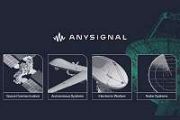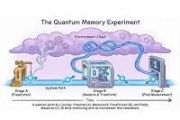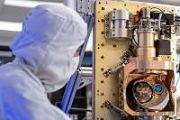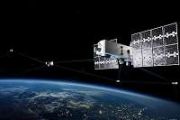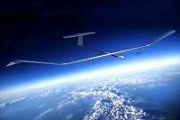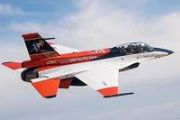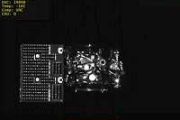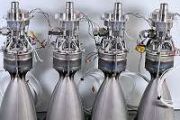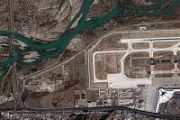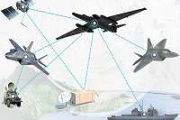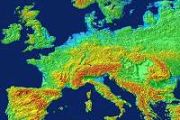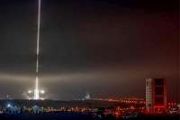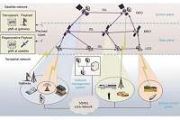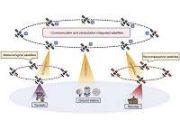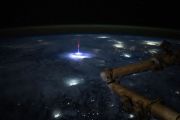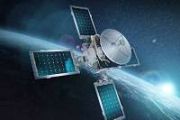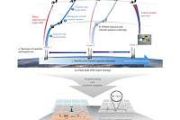
Copernical Team
Watch wind whirl from the Sun
 Video:
00:00:43
Video:
00:00:43
Aside from sunlight, the Sun sends out a gusty stream of particles called the solar wind. The ESA-led Solar Orbiter mission is the first to capture on camera this wind flying out from the Sun in a twisting, whirling motion. The solar wind particles spiral outwards as if caught in a cyclone that extends millions of kilometres from the Sun.
Solar wind rains down on Earth's atmosphere constantly, but the intensity of this rain depends on solar activity. More than just a space phenomenon, solar wind can disrupt our telecommunication and navigation systems.
Solar Orbiter is on a mission to
Webb sees galaxy mysteriously clearing fog of early Universe

Using the unique infrared sensitivity of the NASA/ESA/CSA James Webb Space Telescope, researchers can examine ancient galaxies to probe secrets of the early Universe. Now, an international team of astronomers has identified bright hydrogen emission from a galaxy in an unexpectedly early time in the Universe’s history. The surprise finding is challenging researchers to explain how this light could have pierced the thick fog of neutral hydrogen that filled space at that time.
Planet selected to support California emissions tracking program with satellite data
 Planet Labs PBC (NYSE: PL), a prominent supplier of Earth observation data, has been named the lead subcontractor under California Air Resources Board's (CARB) Satellite Data Purchase Program (SDPP). The multi-year program, valued at $95 million, was awarded to Carbon Mapper, with Planet contributing methane monitoring data derived from its Tanager hyperspectral satellite series, alongside addit
Planet Labs PBC (NYSE: PL), a prominent supplier of Earth observation data, has been named the lead subcontractor under California Air Resources Board's (CARB) Satellite Data Purchase Program (SDPP). The multi-year program, valued at $95 million, was awarded to Carbon Mapper, with Planet contributing methane monitoring data derived from its Tanager hyperspectral satellite series, alongside addit Sidus Space Expands Presence in Asia With Orlaith AI and FeatherEdge Technology
 Sidus Space (NASDAQ: SIDU), a dynamic and forward-looking provider of space mission solutions, has secured a new purchase order from a prominent research and development institution in Asia. This agreement marks Sidus Space's inaugural collaboration in the region and demonstrates the capabilities of its proprietary space-based artificial intelligence and edge computing ecosystem, Orlaith, which
Sidus Space (NASDAQ: SIDU), a dynamic and forward-looking provider of space mission solutions, has secured a new purchase order from a prominent research and development institution in Asia. This agreement marks Sidus Space's inaugural collaboration in the region and demonstrates the capabilities of its proprietary space-based artificial intelligence and edge computing ecosystem, Orlaith, which Maxar unveils Raptor software suite for GPS-free navigation in autonomous systems
 Maxar Intelligence has introduced Raptor, a next-generation software platform engineered to support autonomous drones with reliable navigation and precise ground coordinate extraction in GPS-denied environments. Designed to enhance operational resilience, the software empowers autonomous technologies used in military, humanitarian, and commercial missions globally.
Raptor integrates seamle
Maxar Intelligence has introduced Raptor, a next-generation software platform engineered to support autonomous drones with reliable navigation and precise ground coordinate extraction in GPS-denied environments. Designed to enhance operational resilience, the software empowers autonomous technologies used in military, humanitarian, and commercial missions globally.
Raptor integrates seamle Eco-friendly rare earth element separation: A bioinspired solution to an industry challenge
 From smartphones to wind turbines, rare earth elements (REEs) are an essential part of the hardware in many advanced technologies. These elements, which include the lanthanides along with scandium and yttrium, are the backbone of industries that rely on unique properties such as luminescence, magnetism and catalytic ability. In fact, as our world moves toward more sustainable energy solutions an
From smartphones to wind turbines, rare earth elements (REEs) are an essential part of the hardware in many advanced technologies. These elements, which include the lanthanides along with scandium and yttrium, are the backbone of industries that rely on unique properties such as luminescence, magnetism and catalytic ability. In fact, as our world moves toward more sustainable energy solutions an Airbus adopts Astroscale Gen 2 docking plates for enhanced satellite sustainability
 Astroscale Limited ("Astroscale UK"), the UK arm of Astroscale Holdings Inc., has reached a significant milestone as Airbus Defence and Space becomes the first major commercial buyer of its second-generation docking plates. This landmark order reflects growing industry momentum toward more sustainable space operations.
As orbital debris poses increasing threats to both satellites and the s
Astroscale Limited ("Astroscale UK"), the UK arm of Astroscale Holdings Inc., has reached a significant milestone as Airbus Defence and Space becomes the first major commercial buyer of its second-generation docking plates. This landmark order reflects growing industry momentum toward more sustainable space operations.
As orbital debris poses increasing threats to both satellites and the s NASA's Parker Solar Probe Completes 23rd Close Approach to Sun
 NASA's Parker Solar Probe completed its 23rd close approach to the Sun on March 22, equaling its own distance record by coming within about 3.8 million miles (6.1 million kilometers) of the solar surface.
The close approach (known as perihelion) occurred at 22:42 UTC - or 6:42 p.m. EDT - with Parker Solar Probe moving 430,000 miles per hour (692,000 kilometers per hour) around the Sun, aga
NASA's Parker Solar Probe completed its 23rd close approach to the Sun on March 22, equaling its own distance record by coming within about 3.8 million miles (6.1 million kilometers) of the solar surface.
The close approach (known as perihelion) occurred at 22:42 UTC - or 6:42 p.m. EDT - with Parker Solar Probe moving 430,000 miles per hour (692,000 kilometers per hour) around the Sun, aga FSU researchers part of TESSERACT's hunt for dark matter
 For decades, people have been trying to directly detect dark matter: the missing mass in our universe. Now, research from the FAMU-FSU College of Engineering is making possible a new, super-sensitive detector - and even though it's still in the research and development phase, it's already been able to search for kinds of dark matter that other detectors can't find.
Historically, most dark
For decades, people have been trying to directly detect dark matter: the missing mass in our universe. Now, research from the FAMU-FSU College of Engineering is making possible a new, super-sensitive detector - and even though it's still in the research and development phase, it's already been able to search for kinds of dark matter that other detectors can't find.
Historically, most dark Were large soda lakes the cradle of life
 Phosphorus, alongside nitrogen and carbon, forms one of the fundamental building blocks for life on Earth. It is integral to DNA, RNA, and ATP-molecules essential for storing genetic information and fueling cellular processes. Yet despite its biological importance, phosphorus is comparatively scarce near Earth's surface, both today and in the distant past.
This scarcity presents a major qu
Phosphorus, alongside nitrogen and carbon, forms one of the fundamental building blocks for life on Earth. It is integral to DNA, RNA, and ATP-molecules essential for storing genetic information and fueling cellular processes. Yet despite its biological importance, phosphorus is comparatively scarce near Earth's surface, both today and in the distant past.
This scarcity presents a major qu 
